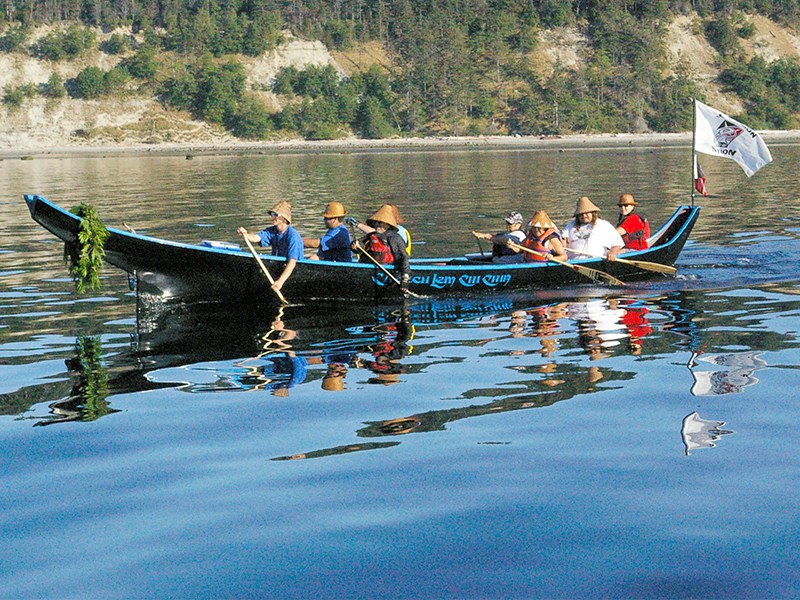Aboriginal experiences have been trending in BC’s tourism sector for the last decade and Tla’amin Nation is positioning itself to claim a piece of the $60 million in potential revenue now available throughout the province annually.
With the opportunity for a wide range of tourism companies to claim financial reward comes the question of cultural appropriation, when one culture takes bits and pieces from another culture that can lead to harmful and even destructive circumstances.
In the case of first nations tourism, Tla’amin Nation hegus Clint Williams said companies should be regulated and those wishing to include first nations content in their tours need to follow certain procedures.
“If somebody wants to use authentic words or pieces of Tla’amin history, they should go through a protocol of getting an approval first,” said Williams. “It’s a little tough to have somebody who is not of our culture try to celebrate our culture.”
Powell River Sea Kayak owner Adam Vallance said the issue of cultural appropriation is one that his company treats very seriously, but that does not stop local guides from including some first nations history in their tours without encroaching upon traditional territory.
“We simply do not go to certain sites,” said Vallance. “You have to be very careful with that.”
Indigenous tourism involves much more than totem poles, carvings and depictions of whales, salmon and traditional masks. It is all of that and more, but complete packages, including food, language, songs and ceremonies, become authentic when first nations operators provide the experiences, said Williams.
Williams said he does not fault non-first nations tour operators for trying to provide the experience of the land.
“But when people book tours and see who their tour guide is,” said Williams, “they’ll know whether they’re having an authentic experience or not.”
Companies without credentials advertising authentic aboriginal experiences have been taken to task, according to Tla’amin citizen and I’Hos Cultural Tours owner Erik Blaney.
“We saw a lot of people hire two or three aboriginal staff and all of a sudden they’re doing cultural tours, meanwhile the company is 100 per cent owned by a non-first nations person,” said Blaney. “We saw a lot of cultural appropriation like that.”
Blaney said he has also seen brochures promoting tours of Harwood Island that include scavenging for artifacts.
“That’s wrong; that’s a private island our people set aside to hunt, fish and clam dig without any disturbances,” he said. “They can’t be advertising a tour like that. It’s great they’re honouring and respecting the nations that allow them to work in their territory, but there’s a fine line.”
Williams said people have violated archaeological sites by taking or destroying artifacts, looking for arrowheads and trading beads. Some tourists have even taken skulls and leg bones.
“We’ve had burial boxes used as kindling to start fires,” he said. “Some of these pieces have sat there for hundreds, if not thousands, of years. Unknowing tourists, whether a kayaker or backpacker, just see this wood and use it to start a fire; it’s someone’s remains they’re burning.”
According to Sunshine Coast Tourism executive director Paul Kamon, first nations tourism has huge potential that cannot be realized without respect and honour for the rights and titles of indigenous traditional territory and culture.
“It is an opportunity for economic development for their communities, as well as ours, acknowledging we are on the home of the Coastal Salish people,” he said.
Kamon said he wants to support Tla’amin as the nation embraces tourism and understands the economic development must be sensitive.
“If they help brand the coast as the Salish Coast, we all win,” said Kamon.
But that has to be done in accordance with the wishes of the Tla’amin people, he added.
BC Aboriginal Tourism Association (ATA) figures compiled over 10 years since the organization began its Aboriginal Cultural Tourism Blueprint Strategy indicate that the industry has grown by 85 per cent.
“That means there are new businesses ranging from arts and culture, resorts, wildlife viewing and outdoor adventure,” said ATA manager of regional initiatives and communications Paula Amos. “On the market side, one in four visitors are seeking an aboriginal tourism experience to add to their travel, so it creates a great time for aboriginal tourism growth.”
As more BC visitors show interest in learning the province’s history through aboriginal heritage, ATA anticipates a 10 per cent growth per year, according to Amos. The association has set a goal to reach $60 million in revenue by the end of 2017.
Within five years, aboriginal experiences are expected to attract 2.2 million tourists who will spend approximately $1.5 billion. Tla’amin sees opportunity in those numbers, said the nation’s community development officer Roy Francis.
“We have the Lund Hotel operation; Tla’amin now owns 100 per cent of the hotel,” said Francis. “Before that we were 51 per cent owners. We’re trying to rebrand it as an aboriginally owned business and moving to emphasize our first nations culture in the operation out there. We’re developing cultural tours.”
Blaney said it is good strategy if Tla’amin approaches the process holistically, similar to Port Hardy’s Kwa’lilas Hotel.
“You know it’s owned by the indigenous nation; they have carvings, coppers, plaques and totem poles, they’re greeted by friendly first nations staff, their logo is first nation and their name is first nation, so they’re doing it right,” said Blaney. “Go to Tofino and they’re far ahead of the game. Even the non-indigenous hotels are all branding indigenously; they’ve been capitalizing on that market for a number of years. They knew something we didn’t.”



